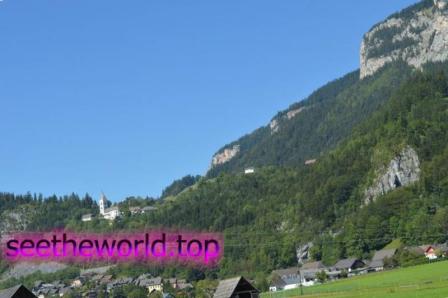In Austria, Styria is one of the most densely populated regions. The administrative center of the country, the city of Graz, is the second largest city in Austria. Styria has a rich history, as evidenced by numerous historical and architectural monuments. Herberstein Castle , the buildings of which were built from the 13th to the 17th century, the abbey in Neuburg an der Muerza , the Mariazell church of the 12th century – all these monuments of history can be seen while traveling in Styria .
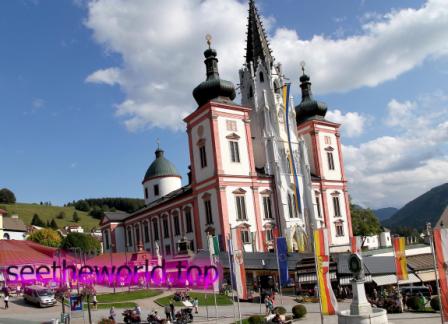
Rest in Styria is inextricably linked with the mountains. Mountains are everywhere, they are the basis of the entire way of life of this region. Today, ski resorts are the backbone of the local economy. The largest mountain area – Dachstein-Tauern , consists of 9 ski areas, each of which has its own infrastructure and separate lifts. The ski season in the mountains of Styria begins in December and lasts until the beginning or even the middle of April. During this time, several thousand athletes and lovers of mountain skiing and snowboarding from all over Europe manage to visit the slopes of Dachstein Tauern.
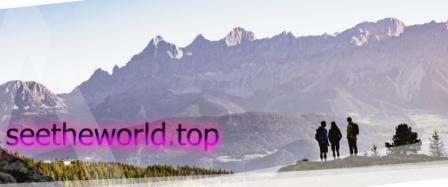
Hotels in Styria
In Styria , hotels offer the most diverse types of accommodation. You can choose hotels in Styria located in picturesque locations surrounded by alpine meadows, vineyards and forests, or you can choose a hotel in the center of a beautiful medieval city such as Graz . Everything depends on the wishes of the guest, because Styria offers its guests a wide choice. One thing cannot be disputed – no matter where a tourist stops in this hospitable land, high-class service according to the highest European standards awaits him everywhere. Styria 5-star hotels and Styria 4 -star hotels can offer many different services in addition to accommodation – from airport transfers to restaurant meals and geothermal baths.

Entertainment in Styria
Like everything in this mountainous region, most of the entertainment in the land of Styria is one way or another connected with the mountains. Even if the guest is far from the idea of skiing or snowboarding, he will always find something to his liking in between tours of monasteries and castles. Hiking mountain tours of various degrees of difficulty are very popular. The duration of such trips varies, from several hours to several days. Most often, such hikes require some effort, but the pleasure gained from traveling through alpine valleys and gorges is difficult to overestimate. Many tourists go to mountain lakes and spend unforgettable picnics in the midst of amazing nature, and fishermen have a great time with a fishing rod.
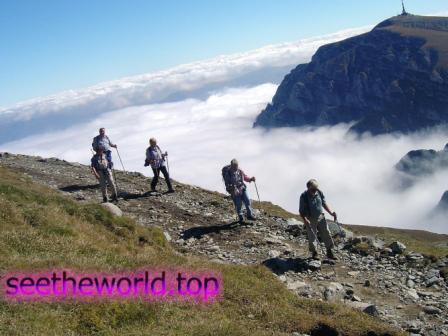
Advantages of tours to Styria
Styria 2018 is no longer the region cut off from the world by mountains, which it was 200 years ago. Now it is not difficult to get here. Graz Airport receives flights from most major airports in Europe. Another large international airport is located in Maribor , in neighboring Slovenia , only 65 km away. You can also get to Styria by rail. The high-speed train will take everyone from Vienna to Graz in just an hour.

The climate of Styria
Styria has a unique climate due to the high location of the land above sea level and the complex alpine terrain. The weather in Styria in the valleys is usually warm and sunny, favorable for agriculture. Styria ‘s weather in the highlands is harsher, with unpredictable winds and heavy rainfall. In general, the climate of Styria is favorable for recreation almost all year round. In winter, the air temperature rarely drops below -2 degrees, and summer is not too hot – + 20- + 25 degrees. The water temperature in Styria in lakes and rivers in summer is usually between +20 and +25 degrees.
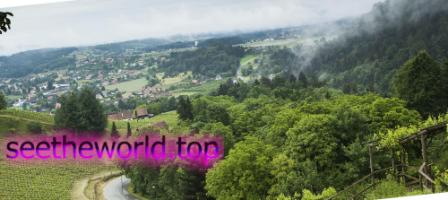
Styrian cuisine
Styria is considered the center of Austrian gastronomy. In addition to simple recipes such as buckwheat roast with lard ( heidenshterz ), a dish made from buckwheat flour, there are also hearty dishes such as roast pork or traditional Styrian fried chicken ( bakhandl ). There is also a salad with “green gold”, that is, with pumpkin seed oil. Styrians wash down all these dishes with local wine or beer.
In general, it must be said that Styria is full of various delicacies, it can rightfully be compared to a fairy-tale country with milky rivers and honeyed shores. Styrian pumpkin oil, schertz, salad with fried chicken or pumpkin cream soup – these are just some of the traditional dishes prepared in Styria .
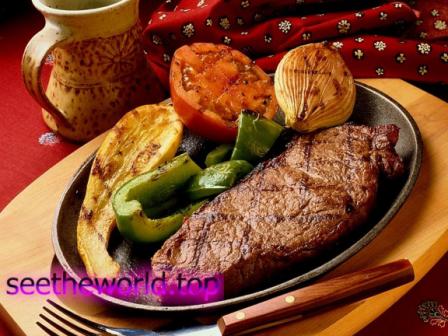
Along with numerous vegetables and fruits, beans are very popular in Styria . Treats with the addition of pumpkin seeds and pumpkin oil are also very popular. “Green gold” is mixed into pastes for sandwiches, bean salad is poured with it, even “babka” is made with it. And all these dishes can have a very different taste – from spicy to clearly sweet.
As for pumpkin seeds, they can be added to bread or dumplings. And being candied, it is perfect for decorating sweet pastries!
An excellent salad dressing is prepared on the basis of pumpkin oil. In addition, pumpkin cream soup is topped with pumpkin butter and crunchy pumpkin seeds.
By the way, pumpkin cream soup is perfect as a first course in the cold season. And if you add ginger to it, it will perfectly warm your whole body!
Park at the bottom of the Green Lake in Styria
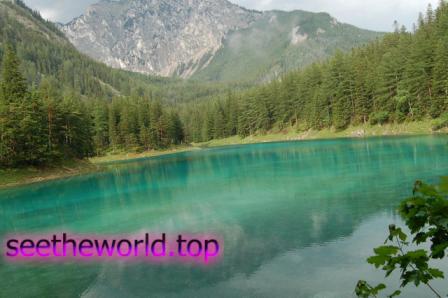
The business card of Styria is Salzkammergut , the so-called “land of lakes”, where many picturesque bodies of water are located. However, few people know that there is another “water” pearl in Styria – Green Lake . Its specificity is that in the summer months it is a deep reservoir with crystal clear water, but by winter it dries up, and around it, as if by a wave of a magic wand, a chic park appears. So how to solve this mystery of nature?
The “highlight” of the Green Lake is that in winter the shallow reservoir freezes completely, a park with cozy benches, small bridges and many paved paths has been built around it for a long time. Local residents like to spend time walking through the park’s alleys.

With the arrival of spring, the snow in the mountains melts, and the depth of the lake increases from 1-2 meters to … 10-12! Everything goes under water: paths, and carefully planted spring flower beds, benches and perennial trees are also flooded. By the time the water floods the entire park, the land has already managed to hide itself with the “green cover” of the alpine meadow, which is why the lake-phenomenon got its name.
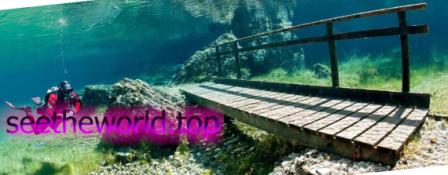
The thawed water is crystal clear, which is why Green Lake is a favorite vacation spot for divers. The depth is quite suitable for scuba diving, divers have an excellent opportunity to observe how fish swim through winding paths, passing abandoned benches. Starting from July, the lake begins to gradually thin out, so that by winter the valley will become dry again, and here again an unusual ghost park has appeared!
Styria has too many attractions for a short walk
Styria is the second largest federal state in Austria , it is called the “green heart” of the country. In this region there are not only majestic mountains and glaciers, but also beautiful lakes, green forests, fields and vineyards – in short, everything necessary for a comfortable life and rest.
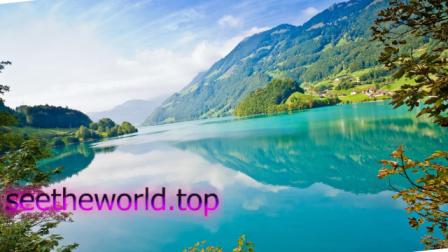
If you love mountains and climbing, here is a rare opportunity to get a mountaineer’s license in the alpine region of Ramsau am Dachstein . You ask how? Simply! It is enough to register for a climber’s course, which is divided into different levels, depending on your physical endurance. After passing it, nothing will stop you from overcoming 17 alpine routes that are publicly available here. Therefore, it should not be surprising that this area is also called the Eldorado of mountaineering in Austria.
But if you are more into photography, you can go to Gezoise National Park , where a photography school regularly takes place. The course lasting several days will take you to magical places, and not only during the day, but also at night.
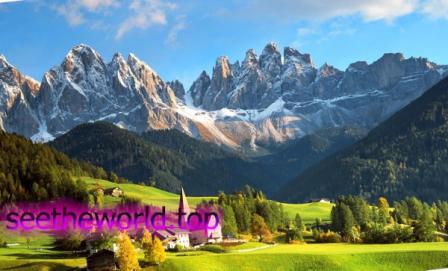
This year, the region opened a new circular cycling route divided into 4 day stages for cycling enthusiasts. The track is ideal for owners of so-called E-bikes, i.e. bicycles with an electric drive, and cyclists in good shape are also welcome here. The cycle route runs through Eastern Styria through the green garden of Austria to the oldest natural landscapes and culinary experiences. On the way, you can admire the castle Hartenschloss , the church Pellauberg , the stalactite cave Tropfsteinhele Katerloch , as well as a distillery, cheese ripening, chicken coop or beekeeping. Are you asking if you also need to carry some sort of cycling map? The answer is no! It is enough to download the application, which will guide you through the most beautiful corners of natureStyria and at the same time advise where to stay.

Tourists must visit the region of Ausserland – Salzkammergut , which offers imposing mountains, transparent lakes, resort parks, many mountain bike trails, where there is also a secret. By secret we mean the so-called ” Mountain of treasures “. It was in this region that they fought to preserve world art, when during the Second World War more than 6,500 paintings, engravings, sculptures or other objects of applied art were hidden in the local salt pit, which had to be destroyed by order of Hitler. Fortunately, that did not happen.
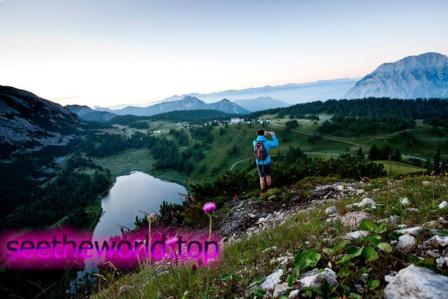
One cannot also forget about the capital of Styria – Graz , which will offer its beauty and history together with culinary experiences. Visitors can enjoy a combination of music festivals with culinary delights, a long table full of different dishes set under the open sky or a sightseeing culinary tour with tastings of excellent dishes and even better types of wines.

Naturally, the offer of individual regions is much more diverse, as we have already mentioned in the previous lines, but this does not change the fact that Styria is an idyllic region that must be visited.
Schladming-Dachstein
Schladming-Dachstein is the most famous resort region of Styria, offering many opportunities for recreation both in winter and in summer. This area is part of the large ski association “Ski amadé” , so in addition to its own 230 km of slopes, Schladming-Dachstein provides its guests with access to another 900 km of slopes of 27 largest alpine resorts.
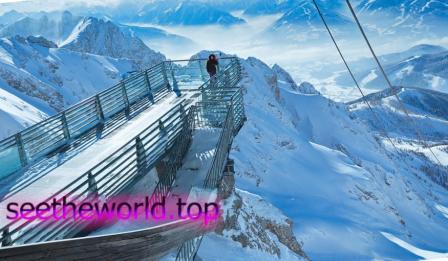
Stages of the largest international sports competitions are regularly held in Schladming-Dachstein. Here are the training bases of biathletes from all over the world, and you can often meet world sports stars on the track.
For summer recreation, the region has more than 1,000 km of hiking trails, 930 km of biking trails (including mountain), 45 running and Nordic walking trails, 4 golf courses, and 14 climbing areas.
Styria: Murtal resort region
Murtal recreation area is located west of the city of Graz in the region of Styria . It hides the peaks of Tauern, Tsirbitskogel, Zetal and Zekauer Alps, as well as the undulating Nockberge mountain massif.
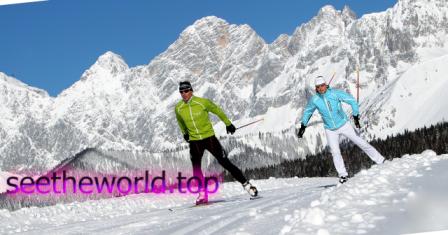
The Murtal region is diverse, colorful and full of impressions. So if you’re planning a vacation, you don’t have to go far, just drop by Austria. While the mountain world of Murtal offers exceptional sports experiences all year round, be it hiking or skiing at an altitude of 800 – 2,700 meters above sea level, the valley area of Murtal offers adrenaline on the racing circuit or interesting activities that are definitely you will not be bored. Let’s go with us on a walk through the nature of Styria , which fascinates with huge mountain pastures, panoramic views from the top of the mountains, or experience adventures during climbing. During your travels, you may come across a special attraction in the form of a so-called Chicken Butler, where you will find free relaxation on sunbeds, sunscreen, photo points (cameras installed to capture moments), new shoelaces, as well as treats in the form of Prosecco and ice cream.
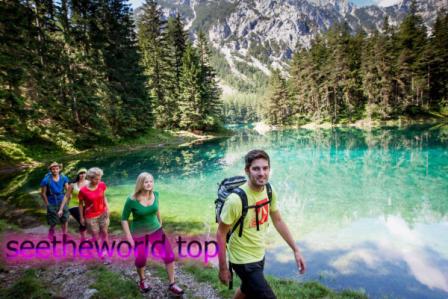
If you decide to visit the green heart of the Murtal region – the nature reserve Čirbitskogel – Hrebinci , which is celebrating its 30th anniversary this year, you can witness various events. In various places of the nature reserve, you can literally “read nature” or, for example, in the first Austrian observatory, “get the stars from the sky.”
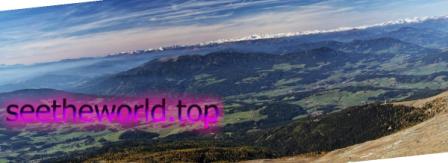
Forests and timber form a large part of the Murtal region. A trip along the Styrian wooden path, which has three priorities, is prepared for visitors. The ” Larch in the Offensive ” project introduces travelers to this mystical tree, 8 themed trails will introduce you to the wood from different points of view, and the third is the wood museum, which is currently celebrating 25 years and provides comprehensive information about its history in the region.

All lovers of nature and flowers are recommended to visit the mountain world of Murtal. He, in the first 4-5 weeks of early summer, opens a beautiful carpet of red flowers of rhododendron rough-haired. Together with regional guides, you can enjoy the beautiful world of red flowers and local home-made delicacies at the same time. If you’re an adrenaline junkie, you can’t miss a visit to the already mentioned racing circuit in Spielberg , where the German racing car championship – DTM is held every year. This year, the Airpower 13 event will also take place in the resort paradise of Murtala . This is an exciting European air show, which will take place at the end of June at the military airfield Hinterstoisser in Zeltweg .

The Murtal region offers visitors, travelers and tourists everything, except the sea. Beautiful mighty mountains, green valleys, top-level services, golf courses, bike trails, horse riding, culinary delights, sporting adventures and much, much more…
Styria is the land of the green heart
Let’s take a look at the largest city and at the same time the capital of Styria – Graz , and in addition we will add some good tips for traveling in the surrounding area.
The federal state of Styria is located in the southeast of Austria. It is the second largest federal state of Austria, located in the neighborhood of Slovenia. It is interesting that the famous Arnold Schwarzenegger was born and grew up here , or Elfrida Jelinek, winner of the Nobel Prize for Literature . But more than famous personalities, Styria is famous for its beautiful and wild nature. It is not for nothing that its symbol is a green heart. It symbolizes the harmony of nature and man. Every guest can make sure of this right away at the first meeting. Residents of Styria sometimes joke: Graz without its surroundings is like a salad without pumpkin oil. And it is in Graz that we will stop for a moment.
The Graz region, together with the surrounding area, has a rich culture and traditions that have preserved its naturalness and independence. Here you will find corners completely untouched by city life, as well as self-confident places with an exceptional atmosphere. The picturesque historic town of Frönleiten , the magnificent pilgrimage church in Judendorff-Strassengel, the idyllic town of Tal Graz , a pilgrimage site for Schwarzenegger fans from all over the world, are just a few of the places that make the Graz city region exceptional.
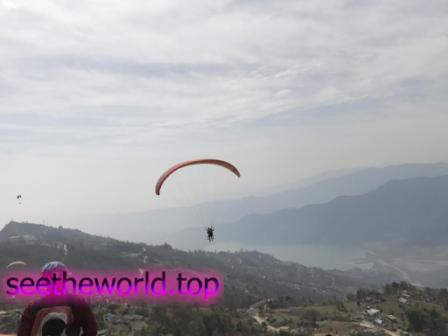
Sports lovers will have fun on countless golf courses, adrenaline junkies will enjoy flying hang gliders or paragliders, tourists and cyclists can explore the hilly terrain here, and romantic lovers can swim in clean natural lakes.

The Graz region will also take care of your stomach. You will definitely not go hungry here, because local taverns with cozy cellars offer a wide range of delicacies. Dishes of local cuisine using white wine and pumpkin oil are typical and traditional elements of local cuisine.
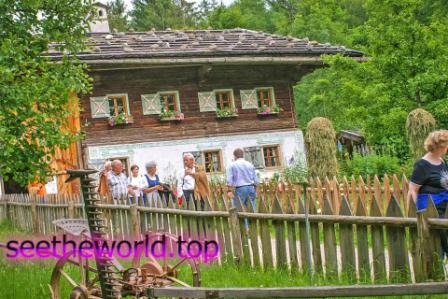
For lovers of culture and history, the open-air museum Stübing should be mentioned, where among 90 alpine buildings, visitors can learn, for example, that people used saunas in the local baths long before we even knew that there was a Finnish sauna. Or you can go to the industrial area of the Hamori Deutschesstrasse monument , or near the Rhine to the oldest Cistercian monastery in the world. In addition to all the mentioned tourist, cultural and sports attractions, accept an invitation to some of the following events.
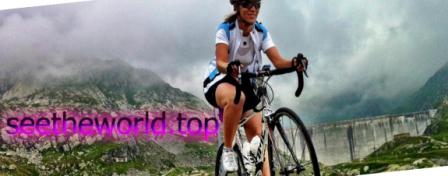
One of the most interesting events this year for athletes is undoubtedly the opening of the cycle tourism season in Statteg . Mountain bikers start a new season here. The Tour de Mur bicycle race also has a stop in Graz, and that’s not all. In addition, for example, the Genuss Spectacle gastronomic festival will be held here , where they will fry, stir, care, taste, eat, drink and dance. “Long table in the middle of the old town” in Graz will also be in the spirit of pleasure for gourmets. This is the eighth season of the event, which takes place right in the heart of Graz – its center. Guests will be able to enjoy the rare atmosphere of this event, the city and the region while tasting the five-course menu.
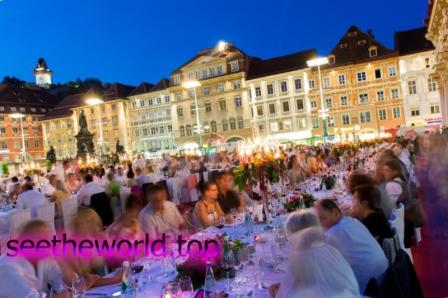
Adrenaline lovers will also have fun in Styria . You will get new experiences in nature, for example, during a 2.5-kilometer flight into the valley on the Zip-line road near the city of Gröbming . This is the largest structure of its kind in Europe. Four daredevils can fly at a speed of 115 km / h down through the valley. For less adventurous types, we recommend a visit to the Dachstein Suspension Bridge , which offers an unobstructed view of the Austrian mountain peaks.
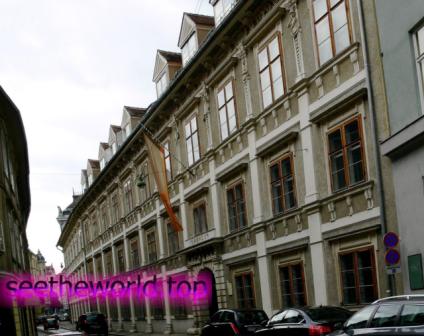
For adventure seekers, Styria offers a cross-border adventure in the form of a treasure hunt, where you have to solve difficult puzzles and take part in various challenges. This extraordinary+ experience takes place on the border with Slovenia under the guidance of local guides. And finally, we will return to Graz again, where we recommend you to visit the reconstructed universal museum Johannheim , which will introduce you to the history of Styria , which lasts 400 million years.
Styria is a beautiful land that offers you much more than you might expect.
Graz: Historical Center
What does the historical center of the university city look like, where, among other things, Johann Kepler also stayed ?
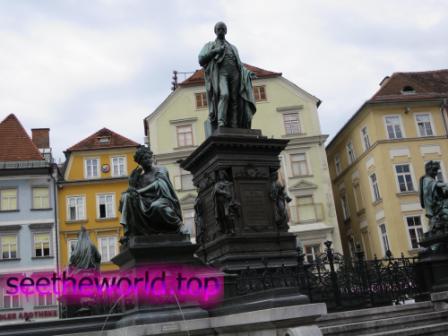
Graz, in German Graz (a word of Slavic origin), is the second largest city in Austria , located near the border with Slovenia and its city Maribor , which is almost 70 kilometers away. The capital Vienna is located approximately 200 km to the north. About one-sixth of Graz’s population is made up of students studying here at its six universities.
Upon arrival in Graz, you will be amazed by its sophistication, cleanliness and beautiful historical architecture, located on the border of the cultural influences of Central Europe, Italy and the Balkan Peninsula. Therefore, it is not surprising that in 1999 the city was included in the list of the world cultural heritage of UNESCO and in 2003 it became the cultural capital of Europe.
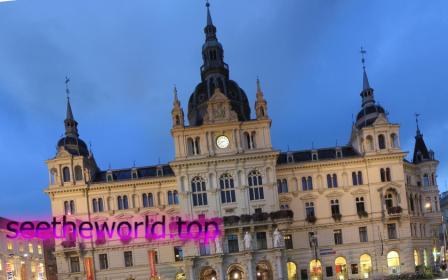
To get to know the historical center you will have enough on your own feet, but nevertheless you can use the large network of public transport, which especially in the center is well served by trams. Graz, among other things, is also a city that provides great opportunities for the movement of cyclists. Everywhere you go you will see cycle paths, so if you like cycling, Graz is the perfect place for you.

While walking around the historic center, be sure to visit the main square, which is dominated by the beautiful town hall . The original city hall, which soon turned out to be too small, stood in the Jewish quarter. In 1550, a new one was built in the Renaissance style, it has a very strict appearance, which was decorated with ornaments only at the corners of the building. The town hall also served as a police station and a prison. The building that can be seen today was built in 1805-1807 on the ruins of the old one, which was demolished. The current building of the town hall is made in the neoclassical style.
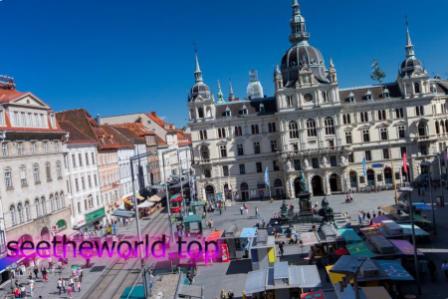
The adjacent main square ( Hauptplatz ) is the real heart of the city. Its center forms the archduke John fountain , the core of which is formed by a life-size statue of the archduke. There are other statues around, which represent the four rivers – Mur, Sava, Drava and Ens.
At the edges of the square there are many significant buildings. These include, for example, the House of Luegg . It was built in the XV-XVI centuries. The baroque style is enriched with beautiful stucco decorations.
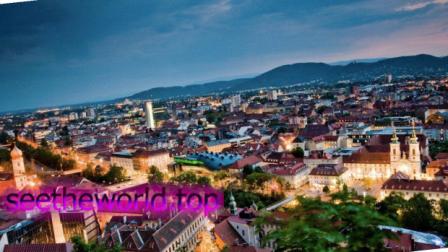
Another significant building on the square is the Styurgka Palace , which originally belonged to the merchant family of the same name and was gradually completed over the centuries, from the Middle Ages to the 20th century. Pay attention to the statue of the Virgin Mary , located in a small arch between the windows.
Khristofor’s burgher house was built in the 17th century. It was named after the fresco of Saint Christopher that adorns its front pediment.
Another interesting building, located on the corner of the square, is the building in which the pharmacy “Adler Apoteke” has been located for almost five hundred years . The current appearance of the building dates back to the 17th century.
Styria – Bear Gorge and Hochlanch Mountain
Austria is an alpine country rich in natural beauty. It is not necessarily the famous ski resorts or the snowy peaks rising to the heavens, the monumental alpine mountains that are worth visiting. No less interesting are two wonderful areas located near the city of Graz in the Grazer Bergland mountains – the Bear Gorge and the Hochlanch mountain .
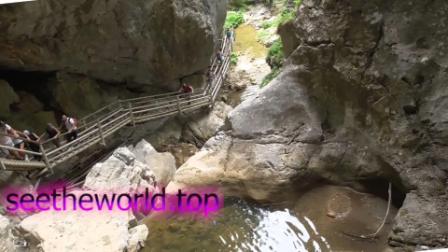
Both of these natural treasures are located in the Austrian federal state of Styria in the Randgebirge östlich der Mur mountain range , which includes the subsystem, the already mentioned part of the Grazer Bergland . The Randgebirge mountain massif to the east of the wall is at the same time the easternmost part of the mountain system of the Central Eastern Alps . The Bear Gorge and Hochlanch Mountain (1,720 m above sea level) are located northwest of the Miksnitz village , which belongs to the Pernegg-an-der-Moor settlement . As the crow flies, this settlement is approximately 28 km north of the surrounding areathe city of Graz . The Bear Gorge is easily accessible by a road leading northeast directly from Mixnitz. At the beginning of the forest behind the village, you need to follow the forest path, which will lead us directly to the customs house and the entrance gate to the gorge.
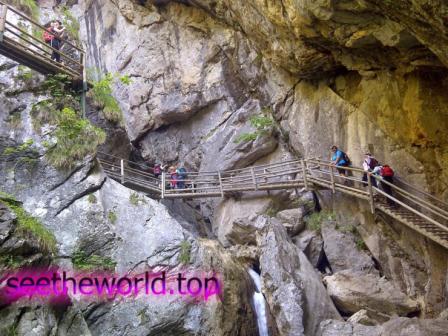
Bear gorge
An organized tourist route leads to the gorge, which is 1,300 m long and has a total height difference of 350 m. The safety of visitors is first of all, many wooden stairs, bridges and railings ensure its safe passage. First of all, the direct entrance to the gorge is significant. The stairs begin to lead steeply up into a narrow ravine surrounded by high walls of massive rocks formed by Paleozoic limestones. The bear gorge was created by the long-term and intensive erosive activity of the Mixnitzbach stream. Fiercely and deeply, he cut into the seemingly solid rock massif and over thousands of years created this magical, awe-inspiring gorge. During the inspection of the Bear Gorge, you will be interested in huge boulders stuck at the bottom of the abyss, numerous cascades and rapidly falling water masses of thundering waterfalls. When you look up, you can admire the relief limestone ravines and rocky canopies leaning over them. After passing through the gorge, we continue on the path through the forest with a slight rise and come to the campsite Zum Guten Hirten , then continue to climb the mountain along the hiking trail to the northeast to the next campsite – Steirischer Jockl .
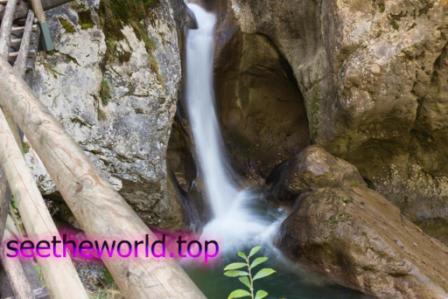
Hohlanch mountain
After arriving at the Steirischer Jockl campsite, we can rest a bit, admire the beautiful views of the surrounding nature or visit the nearby wooden church Schüsserlbrunn . After replenishing our strength, we can continue our hike to Hohlanch Mountain again. The route leads mainly through the forest on a relatively steep terrain, the height difference from the campsite to the top reaches approximately 400 meters. If we are lucky, during the hike we can also see the typical inhabitants of this region – ibex. After a difficult climb up, we leave the forest and find ourselves in an open area, where the tourist route is already surrounded only by dense thickets of pine. After covering a short distance on rocky terrain, we come to the top of Hochlanch. The peak with a height of 1,720 m above sea level is easily recognizable from afar because there is a large cross on it. The reward for the difficult climb is exceptional panoramic views of the surrounding mountain landscape. You will have a divine view of a deep valley, a beautiful picturesque land of endless peaks, the silhouettes of which can be recognized even far on the horizon. The Hochlanch massif is formed by gray limestone of the Devonian period, which is most exposed on its northern side in the form of a high relief rock with walls that drop sharply down to the foot of the summit.
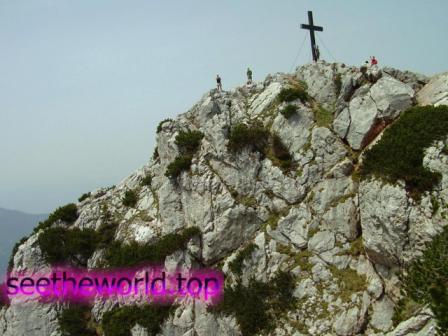
These unusual and charming tourist places, located in the mountains of Grazer Bergland , will leave very deep and pleasant impressions on us for a long time. This is Vedmezha gorge – a grand structure of inanimate nature, created by the unbridled power and energy of the water element, or Khokhlanch mountain – a squat limestone massif that offers stunning views of the wide surroundings.
Upper Styria is a tip for snow lovers
The Upper Styria region offers more than 50 ski lifts and more than 120 kilometers of ski slopes in 18 well-maintained ski centers between Semmering , the Hochschwab Mountains and the Eisenzer Alps .
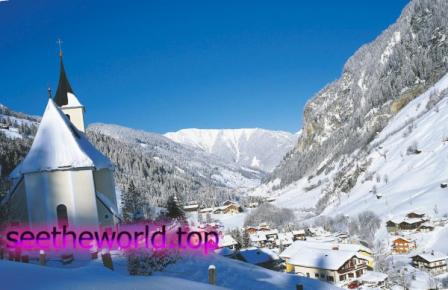
In almost three hours by car, you will get to the winter paradise called Upper Styria, where you will experience entertainment, sports and recreation in nature. If you add regional cuisine and a visit to one of the many Advent fairs, the beginning of this winter season will be a truly unforgettable experience for you.
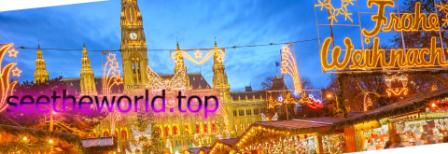
Austrian ski resorts are known to offer a first-class standard not only in ski slopes but also in service, so this time we won’t be recommending just one specific centre. Rather, we will focus on this year’s novelties in general or on interesting events.
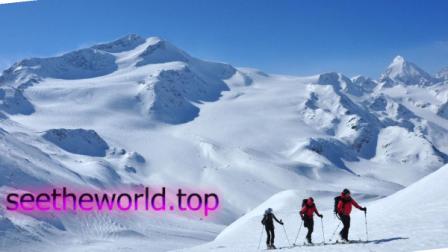
Our first recommendation would include a selection of resorts offering a combination of skiing and good food. So, for example, in the center of Stulek in the panoramic restaurant “W11” you can enjoy good food prepared by the famous chef Yves Weisang. And since good things are always in short supply, after that you can still visit the administrator Max at the Schweigerütte camping site . All three culinary addresses are located right next to the ski slope. In Niederalpl , a ski center for families and snowboarders, winter sports lovers are attracted by the food at the original family mountain resort “Hanzo Hütte” , and you will also find the same in the center of Brunnalm-Hoe Faich. Here, in addition to excellent food, after a day spent skiing, you can relax, for example, in the Faich water park .
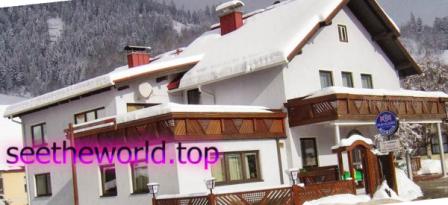
If you love Christmas, there are approximately 50 Advent fairs in towns from Mariazell, through Leoben and Tournau to Trofaich, just for you. Tourists will also like the Advent tours that take place every Advent weekend. On December 5-6, there will be an excursion under the sign of miners’ customs with the feast of St. Barbara, miners’ Advent and a night excursion around the city of Christmas nativity scenes Eisenerts . On the second weekend of December (December 12-13) there will be an excursion to Leoben , the house of Jesus, as well as to the “Magic of Christmas” festival in Stockschloss in Trofaich. On December 19-20, you can take part in an excursion to Kindberg, where soft tones of Styrian Advent songs will be heard. The program of trips and excursions will be completed by a visit to other impressive Christmas markets – starting with Bruck, continuing with Kaufenberg and ending with Mürtzschlag.
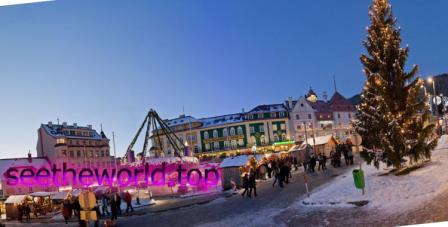
Upper Styria, in addition to the already mentioned ski trails and excursions, also offers many cross-country trails, toboggan runs or the opportunity to play curling. Sightseeing tours cannot be missing, of course, and shopping in cities is very popular at the moment.
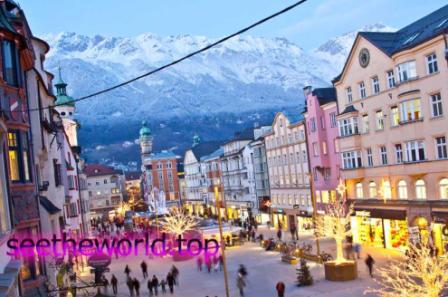
Ski resort Schladming (Styria)
The resort town of Schladming is located in the central part of Austria, in the federal state of Styria . This is a famous ski village bordering the land of Salzburg . Schladming is one of the most prestigious winter resorts in Europe, as well as one of the ten best resorts in the world. This is the largest resort center of the Dachstein-Tauern ski region in Styria . In addition to Schladming, there are 8 more ski resorts in the region with well-equipped skiing tracks connected by a network of lifts. The resort has at its disposal tracks of various levels of difficulty, so beginner athletes and professional skiers and snowboarders come here to rest. In addition, the resort is perfect for fans of slalom and downhill skiing.
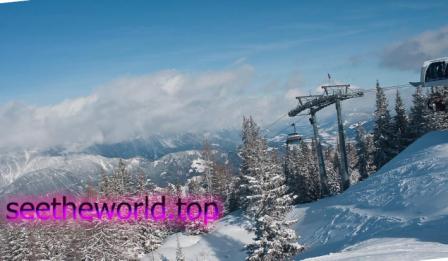
Climate
The climatic conditions of the Schladming resort are complex and ambiguous, as it is simultaneously under the influence of the alpine climate and the Mediterranean climate. In general, there is a moderate climate with fairly warm summers. In summer, it is sunny here and the air temperature reaches + 25C. Winters in Schladming are mild with a lot of snowfall, much more than in other regions of Austria. The skiing and snowboarding season starts at the end of December and lasts until the end of March.
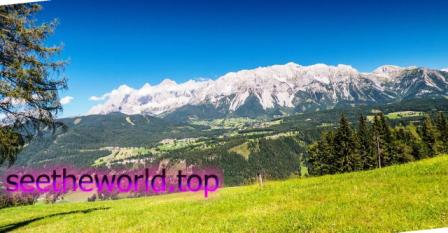
What is here
The federal state of Styria has long been known as a ski resort. Skiing here began back in 1891. And this place became popular after the record set here in 1973 for high-speed downhill skiing at a speed of 111 kilometers per hour. In Styria , ski resorts are treated very carefully, as they carry ancient traditions. Tracks are treated very carefully here. The descents are always well-kept, like nowhere else, and the proper operation of the lifts is closely monitored here. Schladming occupies a leading position among all the resorts of this region, as the most well-kept winter resort. The resort is located at an altitude of 1700 to 2700 meters above sea level. World-class competitions in skiing and sledding are constantly held here.
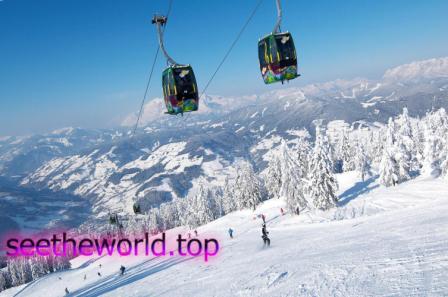
In Schladming, a sufficient number of modern lifts have been prepared for tourists, which connect excellent tracks located on four different mountain peaks. Some of them are equipped with snow guns. Styria , where the Schladming resort is located, is famous for the red wine produced here. Night clubs, cafes, restaurants with national rural and international cuisines are available at the resort for tourists. Bright ski show programs can be seen here.
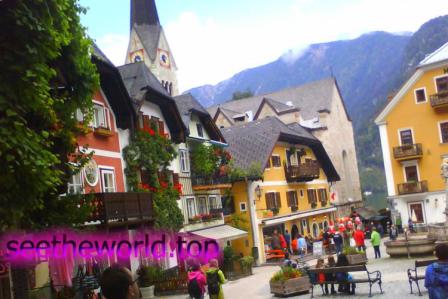
Resort hotels provide high-level service. Here, tourists can do horse riding, archery, go to the swimming pool and sauna, play tennis and squash, go ice skating and engage in hang gliding, rock climbing, mountaineering and other interesting things. There are fitness gyms here, and it is also offered to take a sleigh ride in a romantic evening atmosphere under the stars.
Bad Blumau thermal resort (Styria)
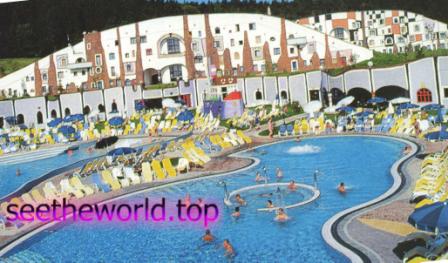
Blumau is a unique, wonderful, but, unfortunately, little-known place in Styria . Once they started looking for oil here, and found healing thermal water. And a unique hotel complex was built right at the source. “What makes him unique?” – you ask… Firstly, it was designed by the famous and original architect Friedensreich Hundertwasser – whose philosophy was to merge with nature and to have no repetitive or familiar lines and elements. As a result, an amazing hotel was built in Blumau by the famous construction company Rogner, in which there are no two straight lines and no similar rooms, the hotel is inscribed in the hills, the grass is green on the roof and trees grow, and vacationers walk along the paths that pass right through the roof of the hotel. And the pools are filled with thermal, healing, highly mineralized water.

The place turned out to be unique and incredibly beautiful! The water in the thermal pools is equally warm all year round. The pools are divided into several zones, each of which has its own water temperature: from hot to cold, which gives its unique healing contrast effect. In addition, there is an artificial wave in the children’s pool, which makes it a favorite place of rest for small tourists.
Well, the thermal water itself has unique healing properties. The use of this unique thermal water and saunas is included in the price of accommodation for guests of the Hotel Rogner Bad Blumau .
The pools and SPA area make up 2,724 square meters of water space.
These are 14 warm indoor and outdoor pools with thermal water from two completely different mineral springs: Melchior – softer in action, with a water temperature of 34-36 ° C and Vulkania – stronger and stronger with a temperature of 36-38 ° C, a pool with fresh with water, a children’s pool with artificial waves, a jacuzzi, a terraced pool with underwater music and massage jets.
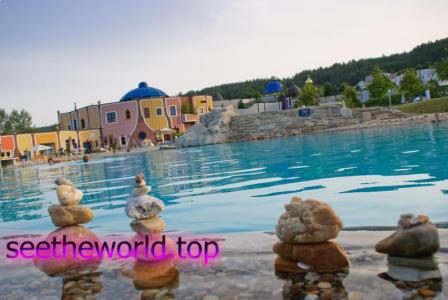
The mineral spring Vulkania strikes from a depth of 2,843 m and has a temperature of 110 ° C – which is the highest mineralized water in Styria (17,621.1 mg/kg).
Vulkania water feeds the Vulkania healing lake – the lake consists of two ponds. One of the pools is filled with fresh water and serves for cooling. Vulkania outdoor pools are surrounded by a garden of 4 elements, lawns with sunbeds and hammocks, offering enough space for solitude and relaxation – this area is more than 30,000 sq.m.
The spa hotel offers a spacious sauna area. Finnish outdoor sauna, sauna in the garden, rock sauna, Roman steam bath, Turkish bath, bio and herbal – Sanare (these are soft, gentle forms of saunas), aroma room with Aquaviva hydromassage bath and cold pool are available for guests. relaxing Biosanarium , in addition Qi Gong in a Roman steam bath and a bath with an open fireplace. And the hotel-resort offers various meditations and special infusions with fruit and flower essences, which not only give taste pleasure, but also perfectly restore strength and health.

Indications for treatment:
Alkaline bicarbonate sodium-magnesium-calcium waters (pH 8.14) of the “Melchior” spring are used for drinking in the treatment of metabolic disorders, diseases of the gastrointestinal tract, liver and biliary tract.
Water from the second source is used for water treatments and in thermal pools.
They treat:
Metabolic disorders:
– violation of a diabetic nature;
Gastrointestinal diseases:
– liver disease;
– inflammation of the gall bladder.
Kidney disease.
Diseases of the musculoskeletal system:
– rheumatic diseases of any nature;
– joint diseases;
– muscular rheumatism (neck, shoulders, back) and much more.
35 therapists of the health center carefully and professionally take care of the health of vacationers, using various combinations of medical procedures offered by the resort.
Rogner Bad Blumau 4 *
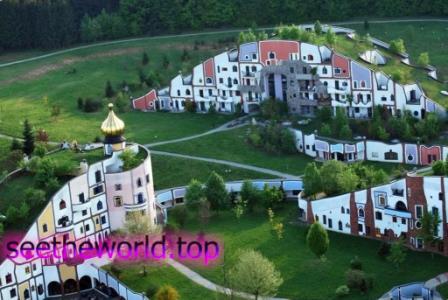
Rogner-Bad Blumau, created by the famous Austrian architect Friedensreich Hundertwasser (15.12.1928 – 19.02.2000), is a work of art, a paradise in complete harmony with nature. This is the only resort complex in the world with an “illogical” architecture taken from a utopia, where every element carries joy, cheerfulness and a charge of energy. Greenery surrounds you everywhere, even on the sloping roofs of buildings there are trees and grass. And the buildings themselves are painted in bright colors and look like fairy-tale dreams. Rest in this fantastic world will bring a lot of joy to both adults and children.

Location of Hotel Rogner Bad Blumau 4 *:
the complex is located 1.5 hours away, between Vienna (130 km) and Graz (60 km), in the center of the Styrian thermal springs region , in a quiet corner on the outskirts of the town of Blumau and surrounded by a hilly landscape. This unusual first-class hotel complex provides various opportunities for recreation and health restoration.
Sights of Styria
Eastern Styria
The arable lands and garden-covered hills of eastern Styria stretch along the borders with Slovenia and Hungary. The rather unremarkable town of Feldbach is considered the starting point for getting to know these regions . main the decoration is Tabor – a fortified quarter of medieval buildings around the church (beginning of the 16th century). Specially built to protect the townspeople in the event of an enemy attack, Tabor more than once performed its direct functions at the beginning of the seventeenth century, when the raids of the Hungarian gajduks literally terrorized the prosperous cities of eastern Austria.
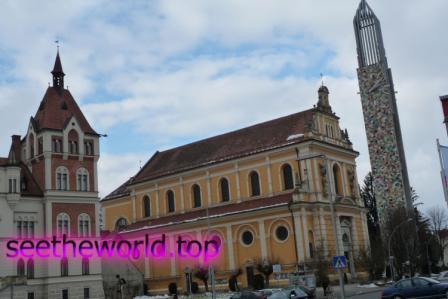
Now there are many local museums, including the old forge, the Styrian Fisheries Museum , the Fire Museum , the Geology Museum and a good ethnographic collection. 2 km to the north of the city rises the Renaissance castle of Komberg , in the art galleries of the pentagonal courtyard, regular historical and artistic exhibitions are now held.
But the main attraction of the district is Riegersburg Castle , located 10 km north of Feldbach, dominating the town of the same name and the fields and pastures of the confluence of the Raba and Rittschein-Bach rivers . Built in 1122 by Rudiger von Hochenberg on a 200-meter-high basalt rock, it was expanded several times until the 17th century, and in the end the length of its walls reached 3 km!
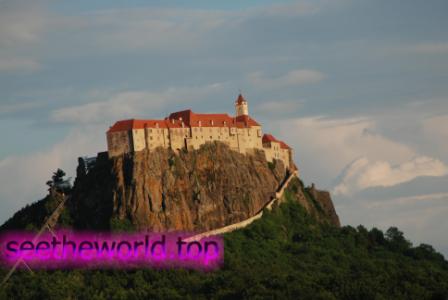
In 1822, the castle was purchased by the Dukes of Liechtenstein and is still used as the residence of this ancient family. However, part of the castle is open to the public, and here you can see a memorial to the victims of the First World War at the gate to the inner fortress, a castle museum with a large collection of weapons and armor, as well as a number of inner rooms and halls that have preserved their ancient appearance.
To the north, closer to the border with Burgenland , you should visit the town of Hartberg (Hartber) , one of the nicest small towns in Styria . It is famous for its well-preserved historical center and soothing landscapes – in these parts, the mountains begin to gradually “encroach” on the fields and gardens, so the Ringkogel mountain, which rises above the city (1,248 m), is literally covered with vineyards and gardens.
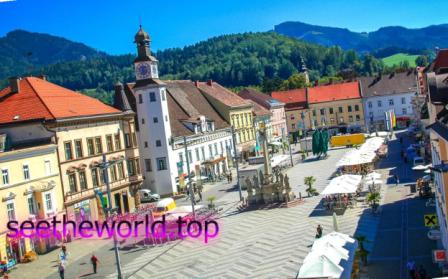
In the southern part of the Hauptplatz stands Hartberg’s business card – the Church of St. Martin with its beautiful baroque altar and squat round Karner tower , originally built as a Romanesque baptistery, inside which the dead were buried (beautiful frescoes of the 13th century have been preserved).
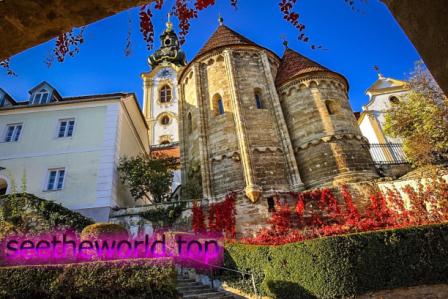
And to the west of the main square there is a good City Museum with a large historical collection (3 km west of the city, excavations are underway at the Roman settlement of Löffelbach). The city castle , significantly modernized in the Renaissance era, now hosts numerous art exhibitions, and from its pre-bridge fortification you can climb to a pleasant city park and the ruins of the once great defense system of the city.
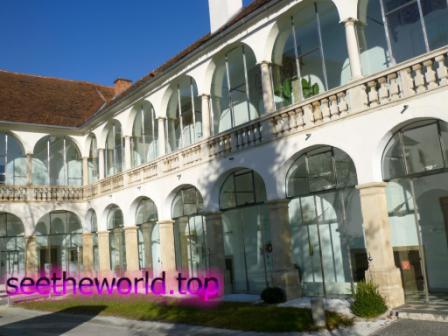
Northern Styria
North of Graz , hills and fields gradually give way to a labyrinth of coniferous valleys and rocky alpine peaks. Despite the undeniable natural beauty, the region is very little known to foreigners – there are no famous mountain resorts or stunning landscapes of the western part of the country, but the Austrians themselves value these lands as a land of peaceful rest.
The visiting card of the region is the lovely pilgrimage center of Mariazell , which lies on the very border with Lower Austria .
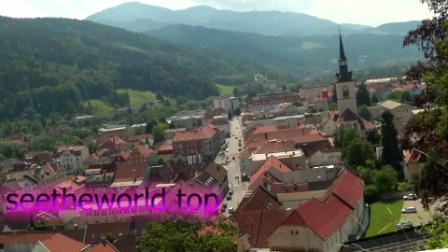
Halfway between Graz and Mariazell lies the town of Bruck an der Moor , which is an excellent starting point for the most beautiful places in northern Styria. 19 km northwest of Bruck lies the town of Leoben , the center of the Austrian metallurgical industry since the Middle Ages.
The interesting town of Eisenerts – both for its attractions and opportunities for active recreation in the nature around it.
Murtal
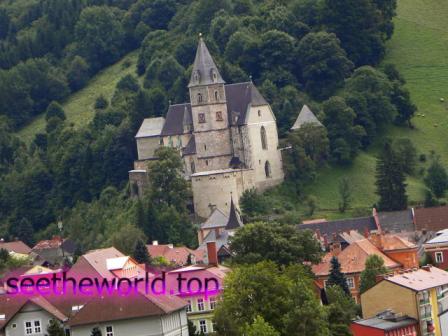
The beauty of the southwestern part of Styria is considered to be the Murtal valley, which stretched from the border of the lands of Salzburg and Carinthia almost to Bruck an der Moor , where the river turns south to Graz . The industrial and commercial town of Knittelfeld (Knittelfeld, 30 km west of Leoben) is considered the starting point for a trip through the valley, although by and large any of a number of small towns in the valley can act in this role. Knittelfeld is the most convenient for visiting the business card of the valley – the Benedictine Abbey of Seckau (Stift Seckau), located 16 km north of the city.
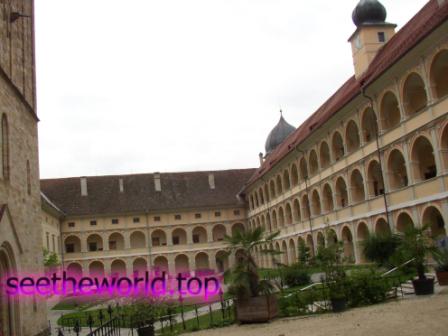
Founded by Augustinians in the middle of the 12th century, the abbey served as the spiritual capital of Styria and the residence of local bishops until 1782, when the bishopric moved to Graz . In 1883, the Benedictines revived the run-down monastery and founded a prestigious high school here, which even today gathers students from all over the valley.
The decoration of the complex is a beautiful Romanesque basilica (XII-XV centuries) with two bell towers, the mausoleum of Charles II (1612), the chapels of the Bishopscapelle (XIII-XVI centuries) and the Sacramentscapelle (XV centuries) with luxurious interiors, galleries of the interior yard, as well as numerous household buildings of different eras.
The town of Judenburg , located 15 km to the southwest, was the leading commercial center of Styria in the late Middle Ages, essentially controlling all trade routes between Vienna, southern Germany and northern Italy . Like most of the other towns in the valley, Judenburg grew rich on the export of iron and, not surprisingly, the lavender trade, becoming an important center of arms by the 15th century.
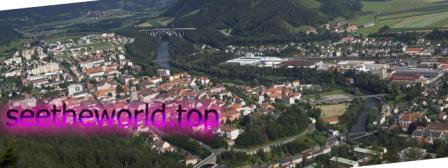
The name of the city is believed to come from the name of one of its early medieval rulers – Yudo, although a popular legend later connected it with a large Jewish colony that settled here in the 13th century. The pogrom of 1496 forced the Jews to flee the city, so few reminders of that time have survived today. Judenburg’s attractions include the colorful central Hauptplatz square with the Stadtturm tower (15th century, 75 meters high), which now hosts various exhibitions, the parish church ( Pfarrkirche , 16th century) with baroque interiors and a Gothic statue of the Madonna with an infant (about 1420), the City and Miner’s Museums , as well as the elegant Magdalenakirche church (1350) on the banks of the Moor.
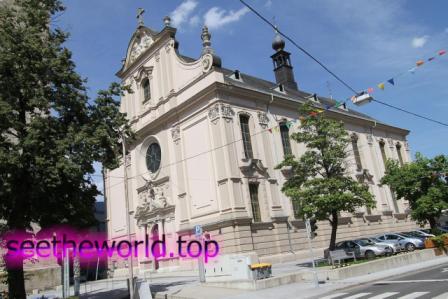
From Judenburg you can go to the ancient center of silver mining – the village of Oberzeiring (Oberzeiring) with its labyrinth of tunnels and shafts, to the church of Frauenburg and the ruins of a 13th-century fortress on the hill north of the town of Unzmarkt (Unzmarkt), to the small village of Oberwolz (Oberwolz) with its significant fortress buildings (in the Middle Ages, this isolated settlement, in which only a thousand people live now, was a successful commercial center, became rich from the trade in salt and silver) or take a ride on the old narrow-gauge Murtalbahn from Unzmarkt to Tamsweg (Tamsweg is already the land of Salzburg) .

Of all the provincial towns in Styria , the old mining center of Murau is probably the most attractive. And 15 km to the southeast of the city, among the green slopes of the Mosalmkogel, Kuhalm and Reiterkogel mountains , there is the town of St. Lambrecht with the Benedictine abbey of the same name , known not only for its churches, but also for its wines since the 11th century.
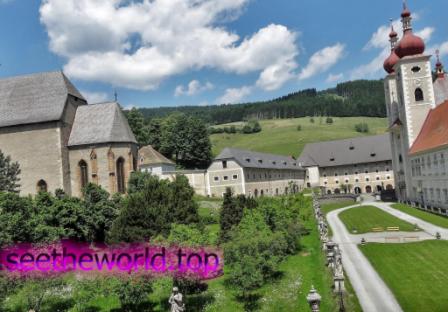
Installation
The mountainous north-west of Styria is occupied by a whole series of ridges of the Salzburg Alps, stretching almost consecutively, separated by the valley of the river Ens . The northern part of this mountainous country, which separates the plains of Graz from the lakes of Salzburg , is formed by the low Totes-Gebirge mountains , which are often called the Ennstaler Alpen. At the southern foot of these mountains, in the very heart of Enstal, lies the city of Admont , founded in the 11th century as a Benedictine monastery .
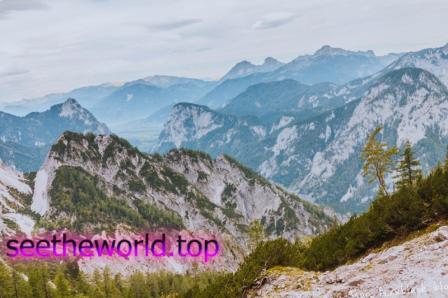
The abbey, which has been rebuilt several times, is still its main attraction today. The monastery museum is simply amazingly rich for a provincial collection, and the library is considered one of the best in the country both in terms of processing and collection of books.
The tourist mecca of Enstal is undoubtedly Schladming , located 60 km to the southwest – one of the largest ski centers in Austria.
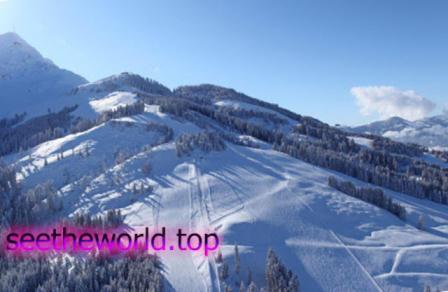
Also in the vicinity of Schladming you can visit Kulm (Ramsau-Kulm) with its beautiful church of the 15th century , Ramsau-Ort (Ramsau-Ort – the main center of hiking tourism and cross-country skiing in the region) with an Evangelical church (16th century, a vivid example of the “survival” of Protestantism in these isolated mountain areas) or climb to the panoramic restaurant Hunerkogel at the top of the Dachstein.
